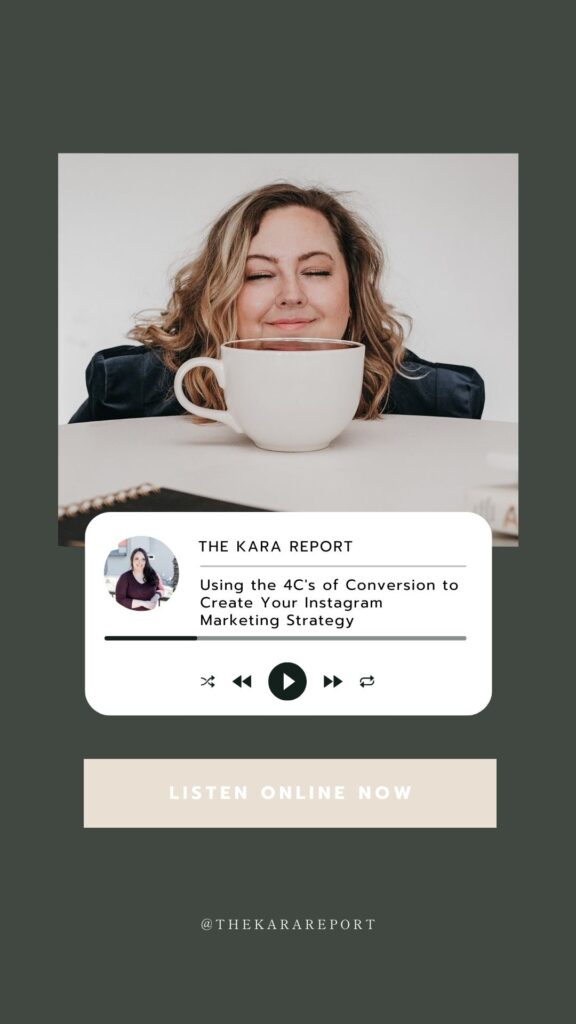I’m in marketing, but I don’t specialize in Instagram marketing strategy. Today, I wanted to bring you guys my biz bestie turned real life bestie, Laura Milroy Media to spill the dirt on what we should be doing and what we need to know about social media strategy in 2024. In this episode, she shares her 4Cs of conversion, what we should be doing with B-roll, how we can become better storytellers, how we can kind of combine Instagram with the rest of our business, and so much more.
Listen on Apple | Listen on Spotify
Table of Contents
Who is Laura from Laura Milroy Media?
If you don’t know who Laura is yet, it’s Laura from Laura Milroy Media and for the last 10 years, she’s brought multiple brands to 6-figure success. She is, as you would say, a social media historian because she has been in the business so long, she’s practically a dinosaur. She is an absolute brand nerd and a champion of small business. I have never met anyone who wants to see small businesses succeed more than Laura, and I can tell you that in her personal life too.

Can you explain the “four seasons of selling”?
The “four seasons of selling” or the “four Cs of conversion” essentially map out a journey that customers go through, especially when we’re talking about social media but really, it applies to all buyer journeys. It starts with consciousness, where you’re getting on your customer’s radar for the first time, showing them you exist.
Then, we move to consideration. At this point, they know you’re around and start thinking, “Is this the one I want to solve my problem with?” If your marketing hits the mark for the right audience, you’ll see them transition to the conversion phase. This doesn’t always mean making a sale right off the bat. It could be as simple as them joining your email list, downloading a guide, or just dropping you a message.
Finally, there’s the community phase. This is where, after they’ve decided to engage with you in some form, you welcome them into your brand’s broader experience and community. So, it’s a progression from becoming aware of your brand to becoming an integral part of your community.
As a social media manager, which stage do you think that we all mess up the most?
Conversion is a tricky part many businesses struggle with. People often think they need to focus a lot on making others aware of their brand, the consciousness phase. But look at us, we both have relatively small audiences and yet, we’re running full-time, successful businesses. It’s because we’ve mastered how to convert our audience.
There’s a common belief that bigger audiences are the key, and sure, they can help. But it’s not just about constantly chasing new clients in the awareness phase. If you get your conversion strategy right, everything else becomes much easier. That’s where I think many miss the mark—they don’t quite nail the conversion messaging.
Regarding the four C’s, do you use reels for one phase and stories for another, or does it really matter?
I mix things up a bit, and there isn’t a perfect formula, but certain content types definitely align better with specific phases. For example, reels and short videos, like TikToks and YouTube shorts, excel in the consciousness phase. TikTok is fantastic for getting noticed, though not as strong for conversions compared to Instagram, partly because you can’t add links easily, which matters more for small businesses like ours.
Reels are key for grabbing attention in the consciousness phase. For consideration, carousel posts and graphics really shine, offering depth that engages potential customers. When it comes to conversion, stories are king. Viewers of your stories are usually your most engaged followers, more so than even your email list subscribers. They’re your loyal fans, tuning in daily, making them more likely to purchase from you.
Stories also play a big role in building community, alongside other platforms like your email list or social groups, depending on your business and social media strategy. This allows for a varied approach to nurturing your community, whether through comments, DMs, or external platforms.
Any Instagram marketing strategy tips for those of us running a business and not living the full-time content creator life?
I’ve got loads of vlog ideas for your business but let me circle back on B-roll. I disagree with the idea that it’s overrated because its success hinges on the message it conveys, not just the visuals. This ties back to our chat on message-first marketing. The real winners in B-roll and video content are those with a compelling message, even if some use clickbait tactics. It’s the substance that hooks people.
For 2024, I’m pushing vlog-style content to my clients, and I get the eyerolls—no one wants to feel like they’re stuck in 2011 YouTube. But here’s the thing: storytelling through vlogs has a magnetic pull because it’s all about the narrative. It’s not just about watching; it’s about connecting with stories, which adds more depth than simple B-roll.
Here’s my advice: just film your everyday activities. Setting up your camera and capturing moments like making coffee or packing orders is easy and effective. This approach ensures you always have content that, with a bit of editing, can serve many purposes. It’s about smartly repurposing content to keep your message in focus, paired with visually appealing backgrounds. So, capturing these moments regularly turns the mundane into engaging content, proving you don’t need to be a full-time YouTuber to create compelling vlogs. It’s all about the message, after all.
Looking at my B-roll folder, I find numerous coffee shots, which seem unrelated to what I do. How can I make this strategy work?
Yeah, I don’t see why not. You can definitely overlay a blogging message over coffee footage. The message is key, so the visuals are secondary. But for vlog content, having it relate to your business helps. If coffee doesn’t tie in, try filming over-the-shoulder shots of your work, like planning client content on Pinterest or Canva, doing keyword research, or using Tailwind. Add a voiceover explaining your process, and people will be hooked.
We’re naturally curious, often zooming in on details like what tools someone uses or how many tabs they have open. Giving viewers a peek into your business process can be really engaging. Capturing content that’s closely related to what you do tends to be more effective than unrelated footage like coffee, but experimenting with various types of content is always a good idea. It’s worth trying everything.

How do you keep repeating that message without it getting stale for you or your audience?
Changing the wording is the simplest way to refresh your message. Really, not enough people utilize thesauruses and dictionaries to find new words. We should move away from repetition. Looking at your offerings, there are numerous perspectives to consider, like the problem, solution, benefits, transformation, or process.
Take a photographer doing wedding photography; they can highlight different aspects, such as the getting ready moments or the detail shots, from various angles. If each aspect of your service is explored from multiple perspectives, you can revisit topics with new visuals or tweaks after a while. Concerns about repetition often halt content creation unnecessarily. With only a small fraction of your audience seeing each post, repeating your message can be beneficial, reaching new viewers each time. I think that being repetitive is something that people worry about more than they need to.
As small business owners, we repurpose content, but where’s the line between repurposing a reel into a carousel, then an email, a TikTok, a YouTube short, and maybe even a blog? Is there a point where it’s too much?
Worrying about repeating ourselves is a big thing, right? But the real question is, how effective is our messaging? If you’re spreading the same content across all these platforms and hearing crickets, maybe it’s time to switch things up. I’m a big believer in repurposing content, in being present everywhere. Yet, it’s essential to tailor your content to each specific platform. There’s a catch, though; we can’t throw our energy into every platform or we’ll just burn out. I firmly believe in focusing on a primary platform, pouring your main efforts there, and using secondary platforms to complement it.
Now, if you’re all in and want to maximize your effort, you might stagger your posts—sharing an idea on Instagram today, then on TikTok tomorrow, and YouTube the day after. This strategy requires a hefty content backlog to maintain consistency across platforms. While not necessary, it’s a tactic for those flush with content. But primarily, concentrate on your main platform, ensuring variety there. Different platforms reach different people—some will read your emails, others will watch your stories, check YouTube, or scroll through TikTok.
The goal is to cast a wide net. If reaching as many people as possible is your aim, diversifying your platform presence is smart. And don’t stress too much about repetition; the chances of someone from YouTube catching the same content on TikTok is pretty slim.
How do you define a holistic marketing strategy?
Everyone needs a website. I’ve seen clients lose their social media accounts, including one with a huge following. She had a website and an email list, which saved her when she lost access to her social account. Thankfully she got her account back. So, It’s definitely risky to rely solely on social media because it’s a rented platform and can be taken away from you at any moment.
Holistic marketing means ensuring all parts of your marketing strategy interconnect. It’s not just about being on one platform; it’s about linking your social media to your email list, your email list to your website, and making everything work together to drive conversions and engagement. This approach creates a network where each component supports the others, capturing people wherever they are—whether they’re scrolling Instagram or checking their email. It allows your audience to move seamlessly through the conversion process, finding value at every touchpoint, which builds trust and increases the likelihood of conversion.

For those considering hiring a social media manager, what should we expect, and how can we collaborate effectively with them?
Social media managers typically fall into two categories: those with a focus on visual content, like photographers and videographers, and those who prioritize messaging and strategy. Your choice should be based on your business needs. For instance, the wedding industry demands beautiful visuals, while product-based businesses need high-quality product photos.
Deciding on the right type of social media manager is crucial. If you have the visuals but lack messaging, opt for someone strategy-focused. Conversely, if you need someone to capture your product in the best light, choose a visually focused manager. This doesn’t mean one lacks the skills of the other, but their primary focus varies.
Once you’ve chosen a social media manager, trust them to do their work. Business owners often feel protective, but remember, you hired them for their expertise. A good social media manager will have a seamless process and should be easy to work with if given the space. They want to deliver results and prove their worth through the metrics.
It’s important to ensure they’re the right fit for your business, as working with someone who doesn’t align with your brand can be challenging. Once you’re past the personality check, let them handle their job; they know what they’re doing.
Did your business ever experience a tipping point?
I’ve been in business long enough to have had many tipping points. Starting my business was a tipping point, and I’m now in my 10th year,. I call myself a social media historian. I have been around since Facebook for business came out and before the dawn of Instagram. My story began out of necessity, not a burning passion, driven by the need for flexibility with a young child at home. Office life, clashing with daycare germs, was not a great situation for me.
Starting my business was out of necessity and a need to manage my own schedule and tasks. Initially, I dove into entrepreneurship before I was ready, facing personal and professional challenges. Business growth wasn’t my focus for the first few years, but necessity soon made it imperative. By 2020, despite the pandemic not significantly affecting my client base, I recognized the struggles of small businesses. This led me to teach marketing, a move driven by demand from those seeking advice. Ironically, prioritizing my own marketing became the tipping point, improving my business significantly.
This might seem obvious for a marketer, but it took time to make my marketing a priority amidst a stable client list. The biggest shift came when I began to focus on marketing my services, a challenge I still face. Yet, this approach has yielded significant results, allowing me to be selective with projects and find ways to assist potential clients indirectly.

LINKS MENTIONED:
- Her recent vlog-style reel we reference: https://www.instagram.com/reel/C2QO_iHvFAc/
- Grab Laura’s Free Guide to B-roll: https://lauramilroymedia.com/small-business-broll/
- Follow Laura on Instagram: https://instagram.com/lauramilroymedia
- FREE guide on how to balance fast and slow marketing strategy: https://thekarareport.com/roadmap
- Learn more about working with our marketing agency here: https://thekarareport.com/services
- Follow me on Instagram: https://instagram.com/thekarareport